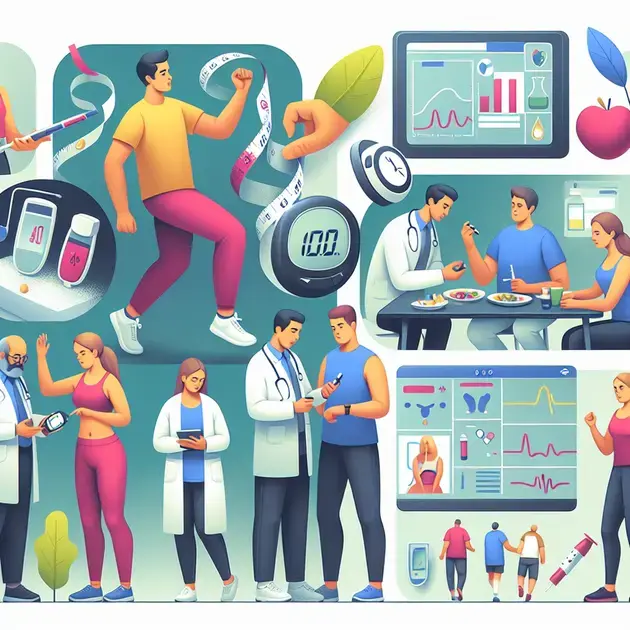
Understanding the Differences Between Type 1 Diabetes and Type 2 Diabetes is crucial for individuals managing these conditions. With Type 1 diabetes, the immune system attacks and destroys insulin-producing cells, while Type 2 diabetes occurs when the body becomes resistant to insulin or doesn’t produce enough. These distinctions impact treatment approaches and overall disease management.
Recent studies have highlighted the importance of personalized treatment plans for both Type 1 and Type 2 diabetes patients. Understanding the unique characteristics of each type can lead to better outcomes and improved quality of life. By raising awareness and promoting education about these differences, individuals can take proactive steps in their healthcare journey.

Key Differences to Know
When it comes to understanding the key differences in treatment options, it’s important to consider factors such as effectiveness, side effects, and cost. One popular app that provides detailed information on various treatments is Healthline. By visiting Healthline’s website or downloading their app, users can access articles and reviews comparing different treatment options for a wide range of health conditions.
Additionally, it’s essential to consult with healthcare professionals to get personalized recommendations based on individual health needs. Apps like WebMD or MyHealth by Humana are useful tools for finding nearby healthcare providers and scheduling appointments for further discussions on treatment considerations.
Moreover, staying informed about recent advancements in treatments is crucial. Subscribing to newsletters from reputable medical websites like Mayo Clinic or Johns Hopkins Medicine can help individuals stay up-to-date on the latest treatments available.
By using these resources and seeking guidance from healthcare professionals, individuals can make well-informed decisions about which treatment options are best suited for their health conditions.
Remember, each individual may respond differently to treatments, so it’s essential to consider personal health history and preferences when evaluating different options.
Treatment Considerations
When exploring treatment considerations, it’s vital to assess factors such as potential risks, benefits, and long-term outcomes. One effective way to gather information on treatment considerations is through the app called Drugs.com. This app provides detailed insights into various medications, including side effects, interactions, and precautions to be aware of.
In addition to app resources, discussing treatment considerations with healthcare providers is crucial. Apps like Zocdoc or Healthgrades can help individuals find and schedule appointments with specialists who can provide expert advice on treatment options.
Furthermore, evaluating the impact of treatments on overall well-being is important. Apps like MyFitnessPal or Fitbit can assist individuals in tracking their health progress while undergoing treatments, allowing them to make informed decisions about their health.
Considering alternative treatments or complementary therapies is also a valuable aspect of treatment considerations. Apps like Headspace or Calm offer meditation and relaxation techniques that can complement traditional treatments for better overall outcomes.
By taking a comprehensive approach to treatment considerations and exploring various resources, individuals can make informed decisions that align with their health goals and preferences.
The Importance of Education
Understanding the importance of education in the realm of healthcare is crucial for making informed decisions about treatments. Khan Academy is a valuable online platform that offers courses on various medical topics, providing users with the knowledge needed to comprehend complex treatment options.
Moreover, seeking guidance from healthcare professionals who prioritize patient education is essential. Apps like HealthTap allow individuals to connect with doctors for virtual consultations, where they can receive detailed explanations about treatment plans and potential outcomes.
Empowering oneself with knowledge about one’s health condition and available treatments can lead to better treatment adherence and improved health outcomes. Utilizing apps like Mango Health, which provide medication reminders and educational resources, can support individuals in managing their treatments effectively.
Engaging in patient advocacy groups or online forums can also enhance one’s understanding of treatment options through shared experiences and insights. Websites like PatientsLikeMe provide a platform for individuals to learn from others undergoing similar treatments.
By placing a strong emphasis on education and utilizing various educational resources, individuals can take an active role in their healthcare journey and make well-informed decisions regarding their treatment plans.

Recognizing Common Symptoms
When it comes to managing blood sugar levels, it is crucial to be able to recognize common symptoms that may indicate fluctuations in glucose levels. One of the most common symptoms is frequent urination, as high blood sugar levels can lead to the kidneys working overtime to filter and absorb the excess sugar. This can result in increased urine production and the need to urinate more frequently.
Another common symptom is increased thirst, as the body tries to flush out the excess sugar through urine, leading to dehydration and the need to drink more fluids. Fatigue is also a common indicator of high or low blood sugar levels, as the body may not be effectively using the glucose for energy production.
Furthermore, sudden weight loss without changes in diet or exercise routines can be a sign of uncontrolled blood sugar levels. This occurs when the body starts burning muscle and fat for energy instead of glucose. It is important to pay attention to these symptoms and consult a healthcare provider for proper diagnosis and treatment.
In addition, blurry vision and slow wound healing are also potential symptoms of blood sugar imbalances. High levels of glucose in the blood can cause changes in the shape of the lens in the eye, leading to blurred vision. Slow wound healing is due to the damaging effects of high blood sugar on the circulatory and immune systems.
By recognizing these common symptoms, individuals can take proactive steps to manage their blood sugar levels effectively and reduce the risks associated with uncontrolled diabetes.
Tips for Managing Blood Sugar Levels
Managing blood sugar levels is essential for overall health and well-being, especially for individuals with diabetes or prediabetes. One of the most important tips for managing blood sugar levels is to follow a balanced and healthy diet. This includes consuming a variety of fruits, vegetables, whole grains, lean proteins, and healthy fats while limiting the intake of processed foods, sugary beverages, and excess carbohydrates.
Regular physical activity is also key in managing blood sugar levels, as exercise helps the body use glucose for energy and improves insulin sensitivity. Aim for at least 150 minutes of moderate-intensity exercise per week, such as brisk walking, cycling, or swimming.
Monitoring blood sugar levels regularly is essential for understanding how food, physical activity, and medications affect glucose levels. Use a blood glucose monitor as directed by a healthcare provider and keep track of the results to make informed decisions about lifestyle choices.
In addition, staying hydrated, getting an adequate amount of quality sleep, and managing stress levels are also important factors in blood sugar management. Dehydration can affect blood sugar levels, while lack of sleep and high stress levels can lead to hormonal imbalances that impact glucose regulation.
By incorporating these tips into daily routines, individuals can effectively manage their blood sugar levels and reduce the risk of complications associated with diabetes.
Preventive Measures to Reduce Risks
Preventing complications related to blood sugar imbalances is crucial for individuals at risk of diabetes or those already diagnosed with the condition. One preventive measure is to maintain a healthy weight through a combination of balanced diet and regular exercise. Excess weight can contribute to insulin resistance and increase the risk of developing type 2 diabetes.
Another important preventive measure is to schedule regular check-ups with a healthcare provider to monitor blood sugar levels, blood pressure, cholesterol levels, and overall health. Early detection of any abnormalities can help prevent complications and guide appropriate treatment plans.
Quitting smoking and reducing alcohol consumption are also essential preventive measures to reduce the risk of cardiovascular complications and other health issues associated with diabetes. Smoking can further damage blood vessels and exacerbate the effects of high blood sugar, while excessive alcohol intake can disrupt glucose regulation.
Eating a diet rich in fiber, antioxidants, and omega-3 fatty acids can also help reduce inflammation, improve blood sugar control, and lower the risk of heart disease. Incorporate foods like fruits, vegetables, nuts, seeds, and fatty fish into meals to support overall health and well-being.
Lastly, staying informed about diabetes management, attending educational sessions, and joining support groups can provide valuable resources and emotional support for individuals looking to reduce the risks associated with blood sugar imbalances.
Conclusion
Managing blood sugar levels is crucial for overall health, especially for individuals with diabetes or prediabetes. Recognizing common symptoms such as frequent urination, increased thirst, fatigue, sudden weight loss, blurry vision, and slow wound healing can help in early detection and prompt treatment. By being proactive in understanding these indicators, individuals can take necessary steps to maintain stable glucose levels and reduce the risks associated with uncontrolled diabetes.
Incorporating a balanced diet rich in fruits, vegetables, whole grains, lean proteins, and healthy fats, while avoiding processed foods and excess carbohydrates, is essential for managing blood sugar levels effectively. Coupled with regular physical activity and monitoring glucose levels, individuals can better control their health outcomes and make informed decisions about their lifestyle choices.
Preventive measures such as maintaining a healthy weight, scheduling regular check-ups, quitting smoking, limiting alcohol intake, and following a diet high in fiber, antioxidants, and omega-3 fatty acids can significantly reduce the risks of complications related to blood sugar imbalances. Staying informed about diabetes management and seeking support from healthcare providers and support groups can further empower individuals to lead healthier lives and mitigate the impacts of fluctuating glucose levels on their overall well-being.